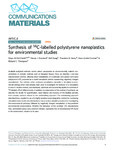Synthesis of 14C-labelled polystyrene nanoplastics for environmental studies
| dc.contributor.author | Al-Sid-Cheikh, M | |
| dc.contributor.author | Rowland, Steven | |
| dc.contributor.author | Kaegi, R | |
| dc.contributor.author | Henry, TB | |
| dc.contributor.author | Cormier, M-A | |
| dc.contributor.author | Thompson, Richard | |
| dc.date.accessioned | 2022-02-17T14:00:55Z | |
| dc.date.available | 2022-02-17T14:00:55Z | |
| dc.date.issued | 2020-12-04 | |
| dc.identifier.issn | 2662-4443 | |
| dc.identifier.issn | 2662-4443 | |
| dc.identifier.other | 97 | |
| dc.identifier.uri | http://hdl.handle.net/10026.1/18814 | |
| dc.description.abstract |
<jats:title>Abstract</jats:title><jats:p>Available analytical methods cannot detect nanoplastics at environmentally realistic concentrations in complex matrices such as biological tissues. Here, we describe a one-step polymerization method, allowing direct radiolabeling of a sulfonate end-capped nano-sized polystyrene (nPS; proposed as a model nanoplastic particle representing negatively charged nanoplastics). The method, which produces nanoplastics trackable in simulated environmental settings which have already been used to investigate the behavior of a nanoplastic in vivo in a bivalve mollusc, was developed, optimized and successfully applied to synthesis of <jats:sup>14</jats:sup>C-labeled nPS of different sizes. In addition to a description of the method of synthesis, we describe the details for quantification, mass balance and recovery of the labelled particles from complex matrices offered by the radiolabelling approach. The radiolabeling approach described here, coupled to use of a highly sensitive autoradiographic method for monitoring nanoplastic body burden and distributions, may provide a valuable procedure for investigating the environmental pathways followed by negatively charged nanoplastics at low predicted environmental concentrations. Whether the behaviour of the synthetic nPS manufactured here, synthesised using a very common inititator, represents that of manufactured nPS found in the environment, remains to be seen.</jats:p> | |
| dc.format.extent | 97- | |
| dc.language | en | |
| dc.language.iso | en | |
| dc.publisher | Nature Research | |
| dc.title | Synthesis of 14C-labelled polystyrene nanoplastics for environmental studies | |
| dc.type | journal-article | |
| dc.type | Journal Article | |
| plymouth.issue | 1 | |
| plymouth.volume | 1 | |
| plymouth.publication-status | Published online | |
| plymouth.journal | Communications Materials | |
| dc.identifier.doi | 10.1038/s43246-020-00097-9 | |
| plymouth.organisational-group | /Plymouth | |
| plymouth.organisational-group | /Plymouth/Faculty of Science and Engineering | |
| plymouth.organisational-group | /Plymouth/Faculty of Science and Engineering/School of Biological and Marine Sciences | |
| plymouth.organisational-group | /Plymouth/REF 2021 Researchers by UoA | |
| plymouth.organisational-group | /Plymouth/REF 2021 Researchers by UoA/UoA07 Earth Systems and Environmental Sciences | |
| plymouth.organisational-group | /Plymouth/Research Groups | |
| plymouth.organisational-group | /Plymouth/Research Groups/Marine Institute | |
| plymouth.organisational-group | /Plymouth/Users by role | |
| plymouth.organisational-group | /Plymouth/Users by role/Academics | |
| plymouth.organisational-group | /Plymouth/Users by role/Researchers in ResearchFish submission | |
| dcterms.dateAccepted | 2020-10-07 | |
| dc.rights.embargodate | 2022-2-18 | |
| dc.identifier.eissn | 2662-4443 | |
| dc.rights.embargoperiod | Not known | |
| rioxxterms.versionofrecord | 10.1038/s43246-020-00097-9 | |
| rioxxterms.licenseref.uri | http://www.rioxx.net/licenses/all-rights-reserved | |
| rioxxterms.licenseref.startdate | 2020-12-04 | |
| rioxxterms.type | Journal Article/Review | |
| plymouth.funder | Distinguishing realistic environmental risks of nanoplastics by investigating fate and toxicology in real-world scenarios::NERC | |
| plymouth.funder | Distinguishing realistic environmental risks of nanoplastics by investigating fate and toxicology in real-world scenarios::NERC |


